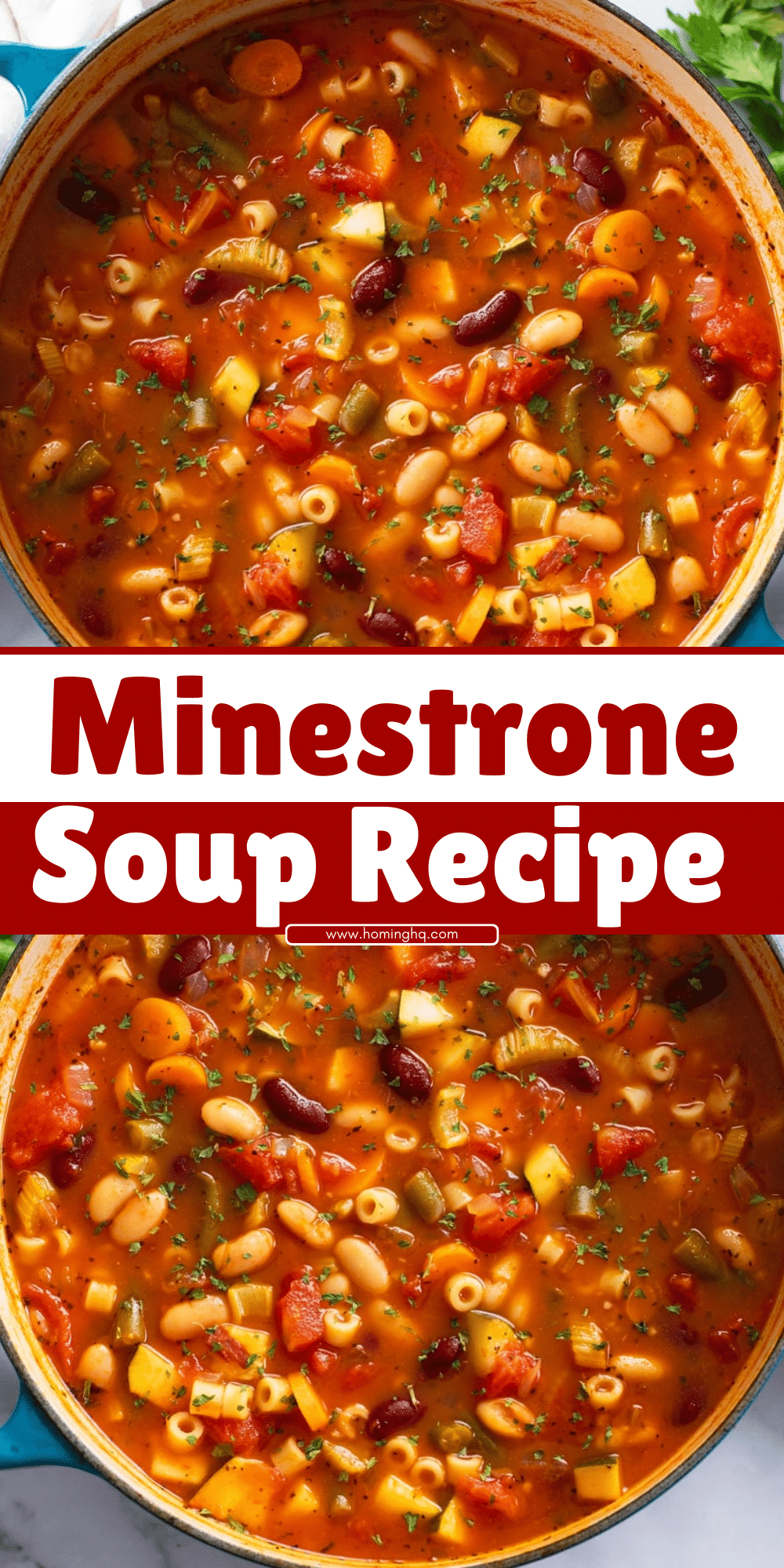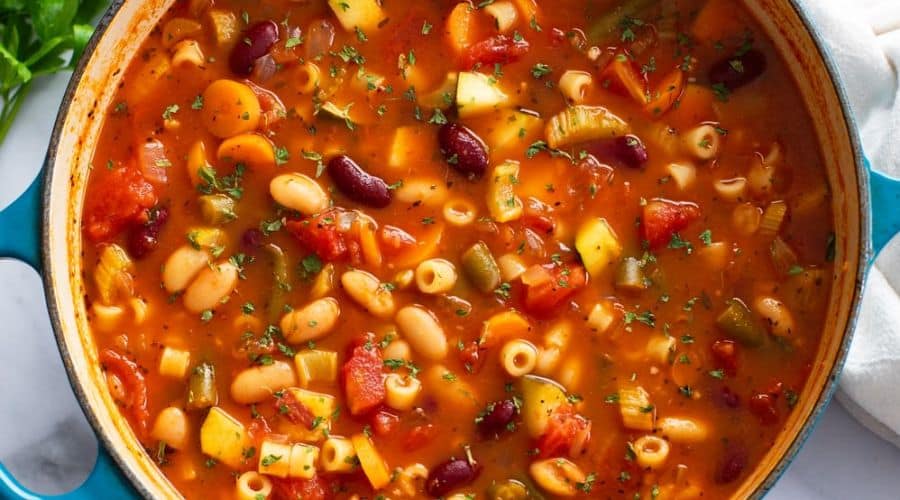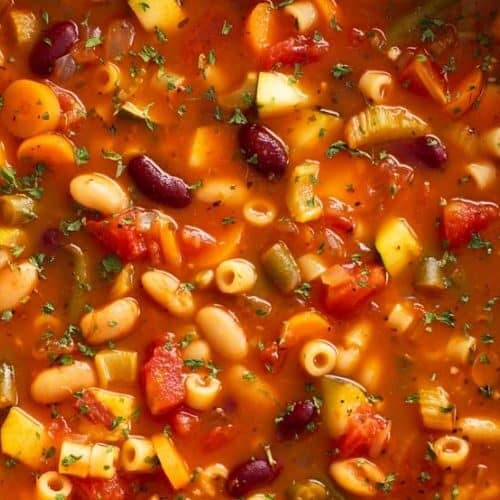Minestrone soup is a timeless Italian classic, celebrated for its rich flavors, hearty ingredients, and nourishing qualities.
Originating from Italy, this vegetable-packed soup was traditionally made with whatever seasonal produce was available, making it a versatile and resourceful dish.
Over time, minestrone has evolved into a beloved comfort food enjoyed worldwide.
This soup is not just about flavor—it’s a wholesome, nutrient-dense meal that provides warmth and satisfaction in every spoonful.
Whether served as a light lunch or a filling dinner, minestrone is a perfect balance of vegetables, beans, pasta, and aromatic herbs simmered in a flavorful broth.
If you’re looking for a cozy, homemade soup that is both nutritious and easy to prepare, this minestrone recipe is exactly what you need.

Why You’ll Love This Recipe
1. Packed with Wholesome Ingredients
Minestrone soup is loaded with fresh vegetables, protein-rich beans, and hearty pasta, making it a well-rounded meal in one bowl.
2. Easy to Customize
One of the best things about minestrone is its adaptability. Whether you follow a vegetarian, vegan, or gluten-free diet, you can modify the ingredients to suit your needs.
3. Perfect for Meal Prep
This soup tastes even better the next day, making it an excellent choice for meal prepping. Store it in the fridge or freezer for a quick and nourishing meal anytime.
4. Rich in Flavor Yet Simple to Make
With just a handful of pantry staples and fresh produce, you can create a deeply satisfying and aromatic soup without much effort.
Ingredients You’ll Need
A great minestrone soup starts with high-quality ingredients. Here’s what you’ll need to bring this dish to life:
Vegetables:
- Carrots, Celery, and Onion – The classic base for rich flavor
- Garlic – Adds depth and aroma
- Zucchini or Green Beans – Adds texture and freshness
- Spinach or Kale – For extra nutrients and a vibrant color
- Canned Tomatoes – Crushed or diced for a tangy, robust broth
Legumes:
- Cannellini Beans, Kidney Beans, or Chickpeas – Provide protein and a creamy texture
Pasta or Grains:
- Small Pasta (Ditalini, Elbow, or Shells) – Classic choice for a hearty consistency
- Rice or Quinoa (Optional) – A great alternative for a gluten-free version
Broth & Seasonings:
- Vegetable Broth – The base that ties everything together
- Italian Herbs (Oregano, Basil, Thyme, Bay Leaves) – Essential for authentic Italian flavor
- Salt & Pepper – To enhance and balance the taste
Optional Additions:
- Parmesan Rind – Infuses the broth with rich umami notes
- Pancetta or Ground Sausage – Adds extra depth for non-vegetarian variations
How to Make Minestrone Soup Step by Step

Step 1: Sauté the Aromatics
In a large pot, heat olive oil over medium heat. Add the chopped onions, garlic, carrots, and celery. Sauté for 5–7 minutes until softened and fragrant. This step builds the foundation of the soup’s deep flavor.
Step 2: Add the Tomatoes and Broth
Pour in the diced or crushed tomatoes, stirring well to deglaze the pot. Add the vegetable broth and bring to a gentle simmer. Let it cook for about 10 minutes to develop richness.
Step 3: Incorporate the Beans and Vegetables
Stir in the drained beans, zucchini, and any other vegetables you’re using. Allow everything to simmer for another 10–15 minutes until the vegetables are tender but not mushy.
Step 4: Cook the Pasta or Grains
Add the pasta directly to the soup and cook according to the package instructions, usually around 8–10 minutes. If using rice or quinoa, adjust the cooking time accordingly.
Step 5: Finish with Greens and Seasoning
Stir in the spinach or kale just before turning off the heat. The residual heat will wilt the greens perfectly. Season with salt, pepper, and any additional herbs to taste.
Step 6: Serve and Enjoy
Ladle the hot soup into bowls and garnish with grated Parmesan cheese or fresh basil. Serve with crusty bread for a complete and satisfying meal.
Would you like me to continue with the next sections?
Pro Tips for the Best Minestrone Soup
1. Use Homemade Broth for Extra Flavor
While store-bought broth works well, using homemade vegetable or chicken broth elevates the taste and adds richness to your soup. If using store-bought, opt for low-sodium to better control the seasoning.
2. Sauté the Vegetables for a Flavorful Base
Don’t rush the sautéing process. Cooking the onions, garlic, carrots, and celery slowly in olive oil helps develop a deeper, more aromatic foundation for the soup.
3. Add the Pasta at the Right Time
To prevent pasta from becoming too soft or soaking up all the broth, add it toward the end of cooking. If you plan to store leftovers, consider cooking the pasta separately and adding it when serving.
4. Let the Soup Rest for Deeper Flavor
Like many soups and stews, minestrone tastes even better after resting for a few hours or overnight. This allows the flavors to meld and intensify.
5. Adjust the Consistency to Your Liking
For a thicker minestrone, mash some of the beans or blend a portion of the soup before adding the pasta. For a brothier version, simply add extra stock or water as needed.
6. Don’t Forget the Parmesan Rind
A small piece of Parmesan rind simmered in the broth adds a rich, umami depth to the soup. Remove it before serving for a subtle yet impactful flavor boost.
7. Customize with Seasonal Ingredients
Minestrone is a flexible dish. Swap in seasonal vegetables like butternut squash in the fall or asparagus in the spring to keep the soup fresh and exciting year-round.
Serving Suggestions
1. Pair with Crusty Bread or Garlic Toast
A bowl of warm minestrone is best enjoyed with a slice of rustic Italian bread or garlic toast, perfect for soaking up the flavorful broth.
2. Top with Fresh Herbs and Parmesan
A sprinkle of freshly grated Parmesan and chopped basil or parsley enhances the soup’s flavors and adds a touch of freshness.
3. Serve with a Side Salad
Pairing minestrone with a simple green salad dressed in olive oil and balsamic vinegar creates a well-balanced and satisfying meal.
4. Add a Protein Boost
For a heartier meal, serve the soup with grilled chicken, shrimp, or a side of white beans drizzled with olive oil and herbs.
5. Make It a Full Italian Feast
For a more complete Italian-inspired dinner, serve minestrone as a starter, followed by a pasta dish or roasted vegetables.
Would you like me to continue with more sections?
How to Store and Reheat
Storing Minestrone Soup
Proper storage ensures that your minestrone soup stays fresh and flavorful for days.
- Refrigerator: Allow the soup to cool completely before transferring it to an airtight container. Store in the fridge for up to 5 days.
- Freezer: Minestrone freezes well! Store in a freezer-safe container for up to 3 months. If freezing, consider leaving out the pasta and adding it fresh when reheating to prevent it from getting mushy.
Reheating Minestrone Soup
- Stovetop: Heat the soup over medium heat, stirring occasionally. If it has thickened, add a splash of broth or water to loosen the consistency.
- Microwave: Reheat individual portions in a microwave-safe bowl, stirring every 30 seconds until heated through.
- From Frozen: Let the soup thaw overnight in the fridge before reheating on the stovetop. If reheating from frozen, use low heat to prevent ingredients from overcooking.
Final Thoughts
Minestrone soup is more than just a meal—it’s a comforting, nourishing dish that brings people together. With its rich flavors, healthy ingredients, and endless customization options, it’s a recipe you’ll want to make again and again. Whether you enjoy it fresh, meal prep for the week, or freeze leftovers for later, minestrone is always a great choice.
Now it’s your turn! Try this homemade minestrone soup, make it your own with your favorite ingredients, and let us know how it turns out. We’d love to hear your favorite variations and serving ideas!
Frequently Asked Questions
1. Can I make minestrone soup without beans?
Yes! If you prefer a bean-free minestrone, simply omit them and add extra vegetables or grains for texture. You can also substitute beans with lentils for a different protein source.
2. What’s the best pasta for minestrone soup?
Small pasta shapes like ditalini, elbow macaroni, or small shells work best. These shapes hold up well in the broth and blend seamlessly with the other ingredients.
3. How do I make minestrone thicker or more brothy?
For a thicker soup, mash some of the beans or blend a portion of the soup before adding the pasta. For a brothier version, simply add extra stock or water as needed.
4. Can I make this soup in a slow cooker or Instant Pot?
Absolutely! For a slow cooker, add all ingredients except pasta and greens, cook on low for 6–8 hours, then stir in pasta and greens 30 minutes before serving. In an Instant Pot, sauté the aromatics, add remaining ingredients (except pasta and greens), pressure cook for 5 minutes, then stir in pasta and greens using the sauté function.
5. What can I use instead of tomatoes in minestrone?
If you’re avoiding tomatoes, replace them with extra broth and a splash of lemon juice or balsamic vinegar for acidity. A small amount of pureed roasted red peppers can also add depth without overpowering the soup.
Would you like me to refine any section further?

Minestrone Soup
Equipment
- 1 Large Pot (6-quart) – For cooking the soup
- 1 wooden spoon for stirring
- 1 Cutting board – for chopping vegetables
- 1 Chef’s Knife – For slicing and dicing
- 1 Measuring Cup Set – For liquids and broth
- 1 Measuring Spoon Set – For seasonings
- 1 Ladle (for serving)
Ingredients
Vegetables:
- 2 tbsp olive oil
- 1 medium onion diced
- 3 cloves garlic minced
- 2 medium carrots diced
- 2 ribs celery diced
- 1 medium zucchini diced
- 1 cup green beans chopped
- 1 can 14.5 oz diced tomatoes
- 4 cups vegetable broth
- 1 cup water
Legumes & Pasta:
- 1 can 15 oz cannellini beans, drained and rinsed
- 1 can 15 oz kidney beans, drained and rinsed
- 1/2 cup small pasta ditalini, elbow, or shells
Seasonings & Additions:
- 1 tsp dried oregano
- 1 tsp dried basil
- 1/2 tsp dried thyme
- 1 bay leaf
- Salt and black pepper to taste
- 2 cups spinach or kale chopped
- 1/4 cup grated Parmesan cheese optional
Instructions
Step 1: Sauté the Aromatics
- Heat olive oil in a large pot over medium heat. Add the diced onion, garlic, carrots, and celery. Sauté for 5–7 minutes until the vegetables are soft and fragrant.
Step 2: Add the Tomatoes and Broth
- Stir in the diced tomatoes (with juices), vegetable broth, and water. Mix well and bring to a gentle simmer.
Step 3: Add Beans and Vegetables
- Add the drained beans, zucchini, and green beans to the pot. Stir in the oregano, basil, thyme, bay leaf, salt, and black pepper. Simmer for 15 minutes.
Step 4: Cook the Pasta
- Add the pasta to the soup and cook for 8–10 minutes, or until tender. Stir occasionally to prevent sticking.
Step 5: Add the Greens
- Turn off the heat and stir in the spinach or kale. Let the soup sit for a few minutes to allow the greens to wilt.
Step 6: Serve and Enjoy
- Remove the bay leaf and ladle the soup into bowls. Garnish with grated Parmesan cheese if desired. Serve warm with crusty bread.
Notes
- Make It Gluten-Free: Use gluten-free pasta or replace it with rice or quinoa.
- Make It Vegan: Omit Parmesan cheese or use a plant-based alternative.
- Storage Tip: Store leftovers in the refrigerator for up to 5 days or freeze for up to 3 months.
- Thicker Soup: Mash some of the beans or blend a portion of the soup before adding pasta.
- More Protein: Add shredded chicken, sausage, or ground turkey for extra heartiness.

